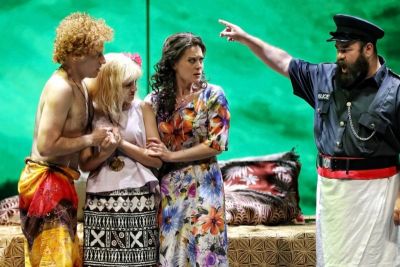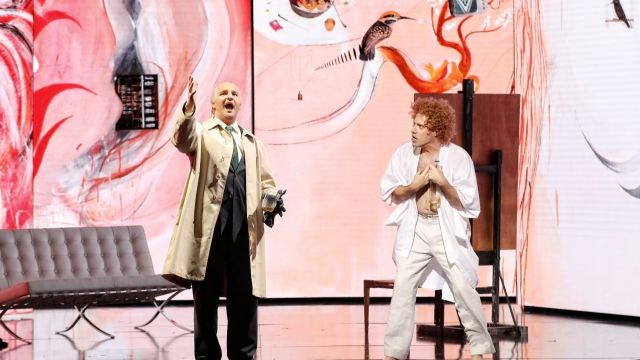Whiteley
When a new opera begins with the lead character calling for the "Hairy Balls Masturbation Club" to meet for a "gang wank" then you know it won't be boring. Even more so when such lyrics are delivered in full operatic voice with all the gravitas of a Wagner aria.
Whiteley wears its Australian spirit on its sleeve: the show's touches of larrikinism and refusal to paint (sorry) Brett Whiteley as a saint add to the impact of this work, especially when it gets more profound. The dashes of irreverence and humour emphasise the deeper messages.
The opera has similarities to two musicals dealing with the creative process: Nine and Sunday in the Park With George. But make no mistake: Whiteley makes some deeper inroads and on its own terms.
For those used to "conventional" operas, do not be afraid. Although the work is composed in a modern style, composer Kats-Chernin and librettist Fleming have avoided the ultra avant-garde 70s-style approach. It's a testimony to their genius that the work is in the modern style but is still accessible. If anything the score reminded me of a modern update on the Golden Age film scores of Steiner, Korngold, Waxman, Herrmann and Tiomkin. These were composers who took the ivory-towered art-house developments in Western music of the first half of the 20th Century and found a way to make them more accessible to the general public. Kats-Chernin also does some cool stuff with the orchestrations, using a traditional symphony orchestra.

Fleming's lyrics travel the range of styles from street talk and direct quotes to ethereal poetry of deep multi-layered meaning."Critics are dildos of Art" is a favourite, and I never before heard, "now f--- off!" sung so beautifully.
There are discussions on the creative process but what is most moving is the human aspect. The scenes dealing with the Christie murders (with the hanging of the innocent accused and the victims singing through their entombed wallpaper), the time spent in Fiji, and the death of friend Joel Elenberg, all mix the human and emotional side with the opera's more intellectual moments in a fitting and moving way. Particularly haunting and moving is the lovers' duet in Act 1, Whiteley's death (it suggests that only in death can he become one with the spirit of Art), and the women's trio at show's end between daughter Arkie, wife Wendy, and mother Beryl, standing like the Three Fates, giving the show a sense of classic myth.
We don't gain any new insights into Whiteley the man, but that's not the point of this work. It successfully explores the universal in the particular. Wife and muse Wendy comes off as an enigma, and I wondered if that was more a case of treading carefully with the real-life Ms Whiteley who was in the audience and helped shape the work. There's no clear narrative other than the opera moving from one scene in Whiteley's life to the next in chronological order. Such a device works in this context.
The massive moving LED screens are back and boy, do they get a work out. The opera is full of powerful visuals in a blaze of colour, styles, and moving videos. Black and white rarely appears. It's like someone set off firecrackers in a paint factory, with Whiteley's major artworks featuring prominently and taking on life. Giotto's 13th century masterpiece "St Francis Preaching to the Birds" sees the birds take flight and I'll leave you to work out the metaphors to that one. There is a short powerful scene which is all-white but I won't spoil it.

Normally such use of scenery and effects is overkill that upstages and detracts from the performers. It certainly reinforced my feeling of watching a movie backed by a superior film score. Given the subject matter it's appropriate, as it creates the impression that the characters and audience have been subsumed into the Great Artistic Void, with giant colours and paintings moving all around us. It suggests that this is what the world may have been like as Whiteley experienced it
There were a couple of times when action and scenes just paused with nothing happening, the excellent orchestra seeming to go into a vamp. I've been reliably informed that the show was only able to get one dress rehearsal before opening, and that there were technical issues at the time that were only discovered then (along with script and score re-writes). In that regard such pauses are understandable and hopefully the issues have been ironed out.
A visual, aural, and intellectual treat of a major new Australian work.
Peter Novakovich
Photographer: Prudence Upton
Subscribe to our E-Newsletter, buy our latest print edition or find a Performing Arts book at Book Nook.

